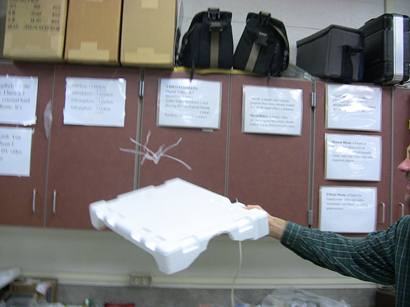I got an e-mail from a gentleman named Nyle Steiner with a link to a video about combining electrostatic levitation with walkalong gliding. Wow!
It was more electrostatic than aerodynamic, but it was still the coolest thing I’ve seen for a long time.
I’d heard of electrostatic levitation before, but it always involved buying a kit or finding exactly the right kind of tinsel or something. But Nyle was a kindred spirit who experimented to find common, household materials to do the job. Then I checked out his non-commercial website of science projects, particularly projects involving electricity, called sparkbangbuzz.com . It’s truly a labor of love, curiosity and genius–a reflection of the man. Informally trained as an electronics engineer, Nyle turned down a job offer to play steadily with the Utah Symphony, to build electronic prototypes in an engineering department. At first he regretted the decision, later realized with all the experience gained he’d made the right decision. He designed and sold music synthesizers and invented the Electric Valve Instrument (or electric trumpet). Playing it, he had a 20 year career scoring on Films such as Apocalypse Now, Witness, Ghost, Dead Poets Society and many TV shows. You can see him playing starting at about a minute into this video.
Now he tinkers with projects and shares them on his website.
Static electricity experiments have always been a bit capricious. The first time I tried electrostatic levitation to my classes throughout the school day, with the first class it was a big hit. But when I tried it with the second class it was a complete flop, just didn’t work!
With the help of Nyles and other friends I’ve learned a lot since that embarrassing day. I’m going to summarize some of the tried and true factors that will help insure your experiments and demos go well. After that, I will just dump some discussion and speculation from e-mails for advanced experimenters. Perhaps people with knowledge of such things will be able to inform us how we can make the experience even better. I confess that I still know relatively little about static charge except that it’s used in photocopy machines, clingy food wrap, some dust collection systems and some spray paint systems. Sometimes it just seems kind of magic!
Hand Levitation
I got a cool e-mail from Stephan Voss and family His account of how he discovered it is here.
“Chance favors the prepared mind” – Louis Pasteur.
May the Force be with you!
Summary of Knowledge to Make Static Electricity Experiments Go Better
Humidity: There is always some water dissolved in air. When air cannot hold any more water it starts to precipitate out, and you get fog and rain. Nyle Steiner lives in relatively dry Utah but he did some experiments with a bathroom with a shower running. As the humidity rose, the levitation degraded to almost nothing.
Rule of thumb: humidity is greater in the summer, air is drier in the winter, particularly in heated buildings. That does not mean that you can’t levitate in the summer, or indoors when it’s raining—we’ve done both. But experiment ahead before you put on that big show.
There’s one other pesky issue that occurred to me, the teacher. If you’ve got a couple of dozen students huddled around your demonstration, you’ve got a couple dozen little humidifiers respirating moisture into the air with each exhalation. I tried to perform a static demo in a smallish room once. It worked great for 1 minute, then went completely dead—just as the kids were getting excited and, I guess, breathing more.
You can use humidity to your advantage, as you will see in the next section about….
Reverse Charge: this is the most maddening thing that’s happened to me. The plastic that I was levitating touched the foam board. Suddenly, instead of repelling, the plastic clings like crazy. Some people report they can just rub again and everything’s all right, but it wasn’t working on my embarrassing day. But here are some things that seem to work. Nyle charged (rubbed) the plastic on a sheet of aluminum foil—such an easy way to remove variables in table top material. I have repeated this. Words great and I’ll never do it any other way.
Nyle also noticed and then confirmed through experimenting that printing ink on some plastic bags can cause charge reversal problems. Dust or other stuff on the plastic or balloon could also cause trouble.
Michael Thompson has experienced reverse charge, too. He breathes on it so the humidity removes the charge, then rubs again.
Best Materials and Shapes: Nyle started it all off with a balloon at the bottom. Thomas Buchwald, another friend is this group of experimenters, substituted bigger piece of rigid foam insulation and I do have an easier time with that, particularly when the plastic shape being levitated is big or slides around quickly.
At the top, Nyle uses plastic grocery bags. There might be some value in using the thinner (lighter) clear little produce bags in grocery stores. Mike also levitates the very thin pieces of the foam sheet that we make walkalong gliders from.
In addition to the shape in Nyle’s video, we’ve all tried various shapes. Rings are cool, repelling to a circle. Mike suggests using a Mobius strip, exposing lots of frontal area in any direction. So it’s more stable in flight than a plain ring, which can slip away.

I’m having fun cutting out rectangles and squares out of the thinnest plastic I can find from grocery produce areas, and cutting in peninsulas or fingers—if you will. They too have great flying stability plus they have unworldly tentacles that radiate out in all directions.
OOPS, it looks like someone already thought to cut lots of little legs into the plastic.
Here’s a funny video that Thomas came across, in German, but anyone can understand it.
Amazing! Spiders that fly using electrostatic levitation!
Sciencetoymaker Home
